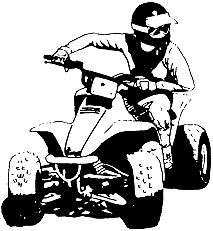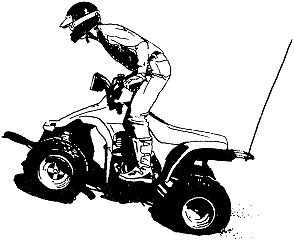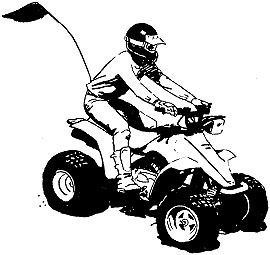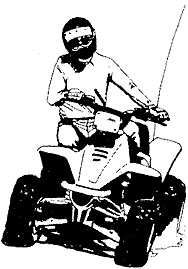Since their introduction, the use of all-terrain vehicles (ATVs) has increased dramatically each year. In addition to widespread recreational use, the agricultural sector has realized the value of the ATV as a workhorse. Unfortunately, fatalities and injuries involving ATVs are occurring at an alarming rate. The Consumer Product Safety Commission estimates that in 1997, the latest year for which statistics are available, 55,400 people were injured in ATV-related accidents in the United States. Many of these accidents could have been prevented by knowing and following a few steps for safe ATV use.
Protective gear
The nature of ATV riding demands that you wear protective clothing. Knowing what to wear and how to wear it can reduce the chance of an injury and make you more comfortable when you ride.
The following protective gear should be worn every time you ride an ATV:
- Helmet
Your helmet is the most important piece of protective gear for safe riding. A helmet can help prevent a serious head injury. Selecting the right helmet is important and easy if a few basic tips are kept in mind. Select a helmet that bears the label of either the Department of Transportation, the American National Standards Institute or the Snell Memorial Foundation. The helmet should fit snugly and be securely fastened. Full-face helmets protect your face as well as your head. Open-face types are lighter and cooler, but should be used with a chin guard that will offer chin and mouth protection. - Eye protection
Eye protection is a must. If an object such as a rock, branch or even a bug hits you in the face, it will distract you and may cause blindness if it hits you in the eyes. Regular sunglasses do not provide adequate protection. The helmet's face shield or a pair of riding goggles will protect your eyes properly. Select well-ventilated goggles that can be securely fastened and are free from scratches. - Gloves
Gloves provide protection from abrasions and help to keep your hands from getting sore, tired or cold. Off-road style motorcycle gloves provide a good combination of protection and comfort. - Boots
Riders should wear boots that lace up at least above the ankle for ankle support, with low heels to help prevent the boot from slipping off the footrests. - Shirt and pants
A long-sleeved shirt and long pants should be worn to reduce abrasions on the body.
Pre-ride inspection
Inspecting the mechanical condition of your ATV before each day's use is important for minimizing the chances of injury or becoming stranded. The fact that you can ride farther in an hour than you can walk in a day emphasizes the need to maintain your ATV in peak operational form. The owner's manual should be used to ensure proper understanding of all critical points on your machine.
Check the following components before using your ATV:
- Tires
Always maintain the recommended tire pressure consistently in each tire. If the tires on your ATV have unequal pressure, the ATV will pull toward the tire with the least air pressure. Most automotive tire pressure gauges will not accurately measure the low pressure typically used in ATV tires. A gauge designed for low pressure should be used. Wheel lug nuts should be checked to make sure they are tight. Grasp each tire at the front and rear, then try to rock the tire on its axle to check for worn-out axle bearings and loose nuts. Always use a torque wrench while following the tightening procedures and specifications for all fasteners outlined in your operator's manual. - Throttle
Check throttle operation while moving the handlebars fully to the left and then fully to the right. An accumulation of mud and dirt can restrict cable movement and prevent the throttle from closing. - Brakes
Your brakes are a crucial part of riding and they must always be in top condition. Make sure they work smoothly and that they are in adjustment according to the instructions in the owner's manual. - Lights and switches
Be sure all lights are working. Check engine stop switches by switching them off and on during the warm-up period. - Oil and fuel
Check the oil and fuel with the engine off. Look for fuel or oil leaks. - Drivetrain and chassis
Inspect your chain for proper adjustment, adequate lubrication and signs of wear. If your ATV is equipped with a drive shaft rather than a chain, check for oil leaks and maintain its oil supply as outlined in your owner's manual. Rough terrain will loosen chassis parts. Look and feel for loose parts while the engine is off. Shake handlebars, footrests and other similar components before each ride, and periodically check major fasteners with a wrench. The operator's manual should be read and understood before attempting to operate your ATV. It will contain specifications and procedures that apply directly to your model and should be considered as the final authority for safe operation of your ATV. Such information may include tire inflation pressures, torque specifications for fasteners, oil types and service intervals, battery maintenance, or brake adjustment and service.
Operating your ATV
Turns

Most ATVs have solid rear axles, which turn each of the rear wheels at the same speed. This requires special turning skills, which primarily involve shifting your body weight. Low-speed turns require that you shift your body weight forward and to the outside of the turn as you turn the handlebar. The objective is to reduce weight on the inside rear wheel. For turns at higher speeds, you must lean your upper body toward the inside of the turn while keeping your weight on the outer footrest (Figure 1). This balances the higher cornering forces as vehicle speed increases. If your ATV starts tipping during a turn at any speed, lean your upper body farther into the turn while gradually reducing the throttle and making the turn wider.
Braking
Begin the braking process by releasing the throttle and shifting to a lower gear well in advance of the intended stopping point. With this method, the engine helps to slow your ATV. Applying brakes smoothly and evenly will bring your ATV to its quickest stop. Apply brakes lightly on slippery surfaces. When descending a hill, shift to a lower gear for engine braking rather than riding the brakes for an extended period of time.
Climbing

The first rule to remember is to stay off hills too steep for your ability or that of your ATV. When approaching a hill, you should keep both feet firmly on the footrests and shift your body weight forward by sliding forward on the seat. For steep hills, stand on the footrests and lean forward to shift as much weight forward as possible (Figure 2). To reduce the chance of stalling the engine, climb hills in a low gear. If the engine does stall, you must apply the brakes before the forward motion stops. If your ATV stalls and then rolls backward, apply brakes slowly. Rapidly applying brakes during a backward roll can cause a rear overturn.
Descending

Before descending a hill, you should shift the transmission into a low gear and point the ATV directly downhill. Keep both feet firmly on the footrests and slide back on the seat to increase your stability and the effectiveness of the brakes (Figure 3).
Riding across slopes

Avoid crossing steep slopes and slopes where there is slippery or bumpy terrain. If you do ride across slopes, keep both feet firmly on the footrests and lean your body uphill (Figure 4). If the ATV begins to tip, turn the front wheels downhill. If the terrain prohibits your turning downhill, dismount on the uphill side immediately.
Additional equipment
Many operators are taking advantage of the additional equipment available to increase the uses of their ATVs. This equipment can be divided into two categories: that which is rigidly mounted on the ATV and pull-type equipment that is towed by the ATV's drawbar. While this equipment can increase your machine's uses, it imposes some new operating restrictions that must be followed for safe operation.
Rigid mount equipment is usually bolted to the front or rear of the machine and includes luggage racks to transport feed or supplies, broadcast seeders and wick applicators for chemical weed control. This type of mounting places the entire weight burden on your ATV. You should realize that this will have a significant impact on the weight and balance of your machine. The center of gravity may be moved to a position of lessened stability. Mounting on the front can make steering more difficult and decrease traction on the rear wheels. Mounting on the rear can increase the chance of a rear overturn. Either mounting can increase the chance of a side overturn and requires added caution when operating on level as well as sloped ground.
Pull-type equipment attached to the drawbar varies from a wagon of firewood to a row-crop sprayer. This type of mounting also has an effect on an ATV's stability. As the amount of drawbar pull required for the load increases, so does the tendency for the front end of the ATV to rise. Caution should be used not to expect more from your ATV than it can safely provide.
Whenever equipment is added, counterweights can be used to offset the load and improve the new balance of your machine. Be careful not to exceed the weight limitations set forth by the ATV manufacturer. Remember, just because your ATV can pull a heavy load does not mean it can safely stop it.
Additional equipment may also require additional protective gear for the operator. Examples of this include protection from objects thrown by a mower and chemical protection from the drift of sprayers.
Age and legal requirements
The majority of ATV accidents involve either young riders, alcohol, passengers, or the use of ATVs on public roads. As a result, the state of Missouri has passed legislation that specifically regulates where and how ATVs can be operated.
Operator age
The Missouri Public Safety Department estimates that in an average year, 44 percent of the ATV accidental death toll involves children under 16 years of age; 20 percent of the fatalities are children under 12. Under the new state legislation, a person under 16 can legally operate an ATV but must be under adult supervision while on land owned by anyone other than the parent or guardian. Parents should remember that while not all children are the same, those under 12 typically lack the physical size and strength, cognitive abilities and motor skills needed to safely operate any size of ATV.
Public highways
Operation of ATVs is prohibited on Missouri highways. Exceptions to this rule include ATVs owned by a government entity, held for official use, or operated for agricultural purposes between sunrise and sunset. The governing body of each city and county also may issue special permits to licensed drivers for special use of ATVs on city streets or county roads. All operators of any ATV being used on a public roadway must have a valid driver's license.
Passengers
No ATV shall carry a passenger except when being used for agricultural purposes.
Alcohol
No person shall operate an ATV while under the influence of alcohol.
Training course
Four major U.S. ATV distributors (Honda, Kawasaki, Suzuki and Yamaha) established the Specialty Vehicle Institute of America (SVIA) in 1983 to promote the safe and responsible use of ATVs. In 1988, the SVIA formed a new division, the ATV Safety Institute (ASI), to expand the availability of their ATV RiderCourse.
ASI offers a free training course to individuals who purchased a new ATV after Dec. 31, 1986. The free training also is available to all members of the purchaser's immediate family who are in the recommended age group for the ATV purchased. The ATV RiderCourse is a one-day, hands-on safety training program. The training includes pre-ride inspections, starting and stopping, turning, operation on hills, emergency stopping and swerving, and riding over obstacles. It also covers protective riding gear, environmental concerns, local laws, and safety techniques. The training course is taught by certified instructors at hundreds of locations across the United States.